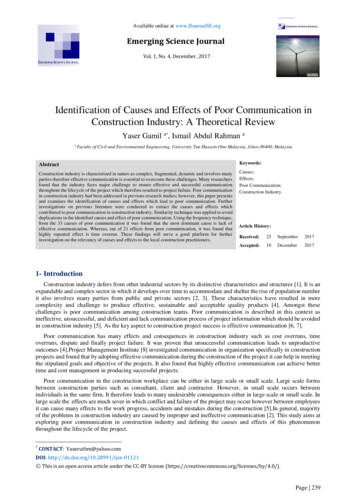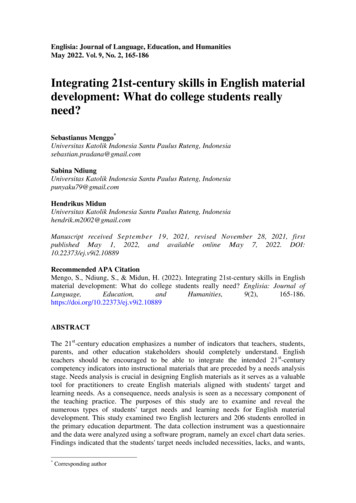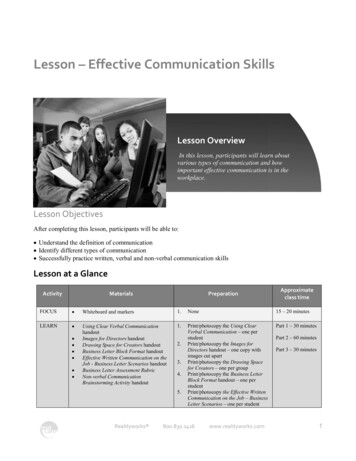
Transcription
Communication Skills forTwentyFive Ways TobuildingStrongrelationshipsA PUBLICATION OF CBT PROFESSIONALS
TABLE OF CONTENTS1Have a Regular Couples Meeting2Set Communication “Ground Rules”3The Speaker-Listener Technique4Assertive Communication5Roadblocks to Good Communication6A Few More Pointers7Time-Out Strategy for Escalating Conflict
1. Have a Regular CouplesMeetingHaving a regular 30-minute meeting with your partner is a great way tokeep connected and build a strong healthy relationship. A great suggestionis to break the meeting in to four parts:1. Appreciation – express gratitude towards your partner for the positivesValues/Goals – share ideas about what is coming up for the week, what’son the “to-do” list, how you will work together towards your shared valuesand goals.2. Plan for Good Times – schedule date nights as well as individual andfamily activities – share how you are going to support one another torecharge and refresh.3. Problems/Challenges – address conflicts, issues and challenges therelationship or life in general are facing.The next set of points will walk you through a set of communicationtechniques that will help towards keeping your communications positive.The more you practice these, the more you will notice your typicalescalating conflicts start to become more constructive communicationswhere everyone feels heard and feels that the problems are beingresolved! [Well that’s the plan in theory! Practice, practice!]
2. Set Communication“Ground Rules”In your first weekly couples meeting, it’s a good suggestion to set somecommunication "ground rules" for handling issues within yourrelationship. These can act as a set of guiding principles that you bothagree to and are there to serve to protect your relationship – veryimportant!Here is an example set of ground rules – but you and your partner shoulddiscuss these and come up with your own unique set of rules.1. When we are having trouble communicating, we will use the SpeakerListener Technique (see Section 3).2. When conflict is escalating, we will call a “time-out” or “pause” andeither (1) try talking again using the Speaker-Listener Technique, or (2)agree to talk about the issue later, at a specified time, using the SpeakerListener Technique. (see Section 7 for how to use the “time-out” strategyeffectively.3. We will completely separate Problem Discussion from ProblemSolution.4. We can bring up issues at any time, but the Listener can say, “this is nota good time”. If the Listener does not want to talk at that time, he or shecan suggest a better time or take the responsibility for setting up a timeto talk in the near future. You will need to decide upon how you willdefine “the near future”.
2. Set Communication “Ground Rules”Continuation 5. We will have weekly/fortnightly/monthly couple meetings. Duringthese times we will note the positive changes we are making and discusswhat we wish to focus on for future change. We will check in with eachother to see if both our needs are being met in the relationship. Schedulea time now for your meeting - there is no time like the present!6. We will make time for great things: fun, friendship, and sensuality. Wewill agree to protect these times from conflict and agree to deal with ourissues at times separate to our positive relationship time.After you have used your ground rules for a while, review and adjust asnecessary - give your new "ground rules" for communicating a chance towork in your relationship before you decide to toss them out.
3. The Speaker- Listener TechniqueIf your attempts to talk to one another often get heated and out of hand,this technique is great to teach you both to slow your communicationsdown so that they don’t get out of hand. Use this technique to discussemotionally sensitive issues, however, it might be a great idea to practicewith easier topics or neutral issues first before discussing more difficultissues so that you can get the hand of the technique.The beauty of this technique is all about slowing your interactions downso that both of you feel heard and understood.
3. The Speaker- Listener TechniqueContinuation Rules for Both of You1. The Speaker has the floor. Use a piece of cardboard/rug to stand on,so you would literally have the floor! Use a real object to designate thefloor such as the TV remote or pen. (The floor has also been referred toas the “talking stick”). The point is that you have to use some specificobject, because if you do not have the floor, you are the Listener.2. Share the floor. You take turns being the speaker during theconversation. This is a trust issue: you trust you will have the floor whenyou need it, so you can pass it to your partner when your partner needsit.3. No problem solving. Focus on having a good discussion, not findingsolutions. You are less likely to hear what each other think about theproblem when you are focused on solving the problem. Try not toproblem solve prematurely.Rules for the Speaker1. Speak for yourself. Talk about your thoughts, feelings, and concerns,not your perceptions of the Listener’s point of view or motives. Try to use“I” statements, and talk about your point of view and feelings. “I wasupset when you forgot our date”, is an “I” statement. “I don’t think youcare about me” is a “you” statement and starts to sound like a criticismrather than an expression of emotional need.
3. The Speaker- Listener TechniqueContinuation 2. Don’t go on and on. Pause to help the Listener understand you. It’svery important that you keep what you say in manageable pieces. Try totackle one issue at a time and not everything that has upset you in thepast week, month or year.3. Stop and let the Listener paraphrase. After saying a bit, stop and allowthe Listener to paraphrase what you just said so you can check that theyhave heard you correctly. If the paraphrase was not quite accurate, youshould politely and gently restate what you meant to say in a way thathelps your partner understand. This is not a test! You want to make itpossible for your partner to understand you.Rules for the Listener1. Listen! This rule sounds easy but the problem is we are often poorlisteners because we are either tyring to think of solutions or thinking ofour own response to say. The key to remember is that you are trying topay attention and understand what your partner’s concern is and wherethere concern is coming from. If you can focus on that, then you won’t befocusing on trying to fix it or defend yourself. So, no interrupting ordisagreeing for the moment – your turn will come.
3. The Speaker- Listener TechniqueContinuation 2. Paraphrase what you hear. When your partner has finished speaking,briefly repeat back what you heard to the Speaker, using your own wordsif you like, and make sure you understand what was said. This will showyour partner that you are listening and is a check-point that youunderstood the message. Remember understanding IS NOT the samething as agreeing with your partner. If you don’t understand, ask theSpeaker to clarify, but you need to limit yourself to just asking forexplanations. Do not mind read.3. Don’t rebut. Focus on the Speaker’s message. As the Listener, you maynot offer your opinion or thought. This is the hardest part of being a goodListener. If you are upset by what your partner says, you need to edit outany responses you may want to make and pay attention to what yourpartner is saying. Wait until you get the floor to make your response. Youwill have your chance, and when you do, you’ll want your partner toextend the same courtesy to you. Any words or gestures to show youropinion are not allowed, including making faces! Avoid giving advice ortrying to fix the problem.
4. Assertive CommunicationWhen levelling with your partner about your problems and concerns,communicating in an assertive manner is going to have the best outcomefor both you and your partner.Assertiveness is most easily learnt by using a simple script. It will help yougive structure to what you want to say and keep you focused. A scriptalso has the advantage of permitting you to develop a statement inadvance, practicing it by yourself or with someone you trust, and finallydelivering it with greater confidence when you need to.There are three basic components to an assertiveness statement:1. “I feel”. The purpose is to give a brief description of any emotiontriggered in you by the situation. It is an “I” statement, about you andyour feelings. “I feel hurt” “I feel upset” “I feel angry”2. Describe the problem. This part focuses on the facts and yourunderstanding of what’s going on. Do not include judgments orassumptions about the other person’s motives; rather, give a cleardescription of events and experiences that you need to talk about. Avoidusing “you” statements in your descriptions.
4. Assertive CommunicationContinuation “we haven’t spent much time together lately”“the housework isn’t being shared fairly”“that we haven’t had time for intimacy lately”Using “I” statements to describe the situation helps to avoid makingaccusations and blaming statements, which tend to make others feeldefensive and less willing to listen or compromise. Blaming statementsstart with “you” and are called “you” statements. “you don’t care about us”“you’re hurting me”“you’re always late”“you don’t help me”Be careful not to dress “you” statements up to look like “I” statements.This charade is usually obvious because the sentence starts, “I feel thatyou ” “I feel that you are selfish”“I feel that you are never home”“I feel that you manipulate me”You might feel that there are truths to these statements, but using suchlanguage to convey your disappointments and hurts comes across as anaggressive attack and this is rarely helpful and will only lead to yourpartner having a natural response to argue back and defend themselves.
4. Assertive CommunicationContinuation You might feel that there are truths to these statements, but using suchlanguage to convey your disappointments and hurts comes across as anaggressive attack and this is rarely helpful and will only lead to yourpartner having a natural response to argue back and defend themselves.3. “I would prefer it if ”. This is the part where you can assert your ownneeds and make polite requests for change. It provides the significantother with information about what changes you would like to happen.Here are some guidelines to follow: Ask for behavioral, not attitude change. You can’t reasonably expectsomeone to change what they believe or feel just because you don’tlike it. Beliefs and feelings aren’t usually in voluntary control. But youcan ask someone to change how they act and what they do. Ask for one change at a time. Don’t give a laundry list. Thatoverwhelms people and makes them feel pressured. Ask for something that can be changed now. “The next time we go onvacation, I would prefer it if .” This is a poor statement because it willbe long forgotten. Be specific and concrete. Vague request such as “be nicer” or “helpmore” don’t provide a clear picture of what you would like to seehappen. Give specific statements of what it is you are requesting. E.g.,“I would prefer it if you did not yell at me” or “I would prefer it if youcould help with the dishes while I bath the kids”.
4. Assertive CommunicationContinuation So putting it all together, we get:I feel [feeling]When [describe the problem situationwithout using you]I would like it if [make request for change]Exercise: Developing Your Own Assertiveness:To develop your assertiveness skills, practice being assertive aroundpositive feelings1) HAPPINESSI feel HAPPYWhenI would like it if2) GRATITUDEI feel GRATEFULWhenI would like it if
4. Assertive CommunicationContinuation HomeworkPractice leveling your positive feelings daily. Set aside 5 to 10 minutes aday to tell your partner about the positive things you are seeing yourpartner do that makes you happy. Whilst this may seem silly, it is thenecessary groundwork for developing the skills to communicate aboutthe negatives.Tick each box on the days that you completed the task:MonTueWedThursFriSatSunOnce you’re feeling confident being assertive around positive emotions,you can move on to more trickier or emotionally “hot” topics. Don’tforget to use these skills in combination with the Listener-SpeakerTechnique and Problem Solving skills.
5. Roadblocks to GoodCommunicationThere are a number of “do’s” and “don’ts” when it comes tocommunicating. We’ve compiled a list for you to reflect on your owncommunication styles. Remember you are working to change yourcommunication style – not your partners! So as you read the list askyourself “do I do that?” and if you identify some “don’ts” as part of yourcommunication style, you can work on by looking at the alternative “Do”.DON’TS Long lectures or “sermons” Blaming (e.g., “you need to stop” “It’s your fault” etc) DO’S Use brief statements of 10words or less Use I statements (e.g., “I feelwhen ” or takeresponsibility for your ownactionsVague statements (e.g., “Shapeup,” “Knock it off,” “I don’t likethat” etc) Use direct and specificstatements (e.g., “Please don’tthreaten me”)Asking negative questions (e.g.,“Why do you always do that?”“How many times must I tellyou?”) Use direct and specificstatements (e.g., “Pleases don’tcall me names”)
5. Roadblocks to Good CommunicationContinuation DON’TSDO’S Poor listening with looking away,silent treatment, crossing arms,and so forth Actively listen with good eyecontact, leaning forward, nodding,and so forth Interrupting others Not checking to see if you reallyunderstand othersLet each person completely statehis/her thoughts before statingyours Give feedback/paraphrase (e.g.,restate what another said to you) Put-downs (e.g., “You’reworthless,” “I’m sick of you,” etc),threats, and so forth Be constructive (e.g,. “I’mconcerned about your grades,”“Something is bothering me; canwe discuss it?” etc) Yelling, screaming and so forth Use a neutral/ natural tone ofvoice
5. Roadblocks to Good CommunicationContinuation DON’TS Sarcasm Bringing up old issues, pastbehavior Put-downs (e.g., “You’reworthless,” “I’m sick of you,” etc),threats, and so forth Not matching verbal and nonverbal communications (e.g.,saying “I love you”, whilepounding one’s fist angrily on thetable. Keeping feelings inside.DO’S Say what you mean be specific andstraightforward Let each person completely statehis/her thoughts before statingyours Stay on one topic Match verbal and non verbalcommunication (saying “I loveyou” while smiling. Express feelings to othersappropriately
5. Roadblocks to Good CommunicationContinuation DON’TSDO’S Scowling, directing antagonisticfacial expression toward others Use appropriate facial expressiontoward others. “Mind reading” or assuming youknow what other people think Really listen to others’ point ofview; ask questions to make sureyou understand.
6. A few more pointers:Here’s a few more pointers to keep in mind when talking with yourpartner and working on your relationship problems:1. Think Straight, Don’t Overreact: Stay calm Use a coping statement Check your self-talk for unhelpful thinking and beliefs2. Communicate effectively:Be assertive, listen, take turns to speak, validate your partner3. Maybe, make a request: Clear, observable and positive4. Maybe, start problem-solving Look for a win-win solution that meets both partners needs5. If necessary, stop arguing: Stop discussion, take time to cool down, and start again afreshIf you’re finding your arguments are escalating, then the next tip may justbe what you need.
7. Time-Out Strategy for EscalatingConflictUsing a "time-out", just as a sports coach would by signalling a "T" with theirhands and taking time out of the game to re-think and re-structure a gameplan - can be an effective communication strategy to manage couple'sescalating communications.The 6 steps to taking a "time-out“1. Recognise that you are experiencing an internal build-up of intense emotion(i.e., anger). Pay attention to the physical indicators your body is sending you.2. Say to the person you are in conflict with "I am beginning tofeel ." and "I need to take some time-out. I’ll be back to talk aboutthis when I have calmed down". If you find your level of anger is beyond beingable to communicate this message effectively, simply signal time-out with yourhands by making a "T".3. Walk away from the situation completely.4. Do something you know helps you to feel calm (go for a walk, call a friend,draw, garden, read, breath, etc.).5. Stay away until you are calm. You might like to think about how you aregoing to "respond" to your partner, rather than "react" to your partner. Whatis it that you are feeling and thinking about the issue at hand?
7. Time-Out Strategy for Escalating ConflictContinuation 6. Return to your partner and come up with ideas about what you want orneed and how things can be different. If still emotional, nominate when youwill talk again.You will need to discuss the "time-out" strategy with your partner before it isused. The purpose of a "time-out" is to help you to calm down (not avoiddiscussing difficult issues) and to sort out a response (as opposed to areaction) that will best get your message across.Always come back to your partner - this will make it easier for your partner togive you the space you need the next time you call a ‘time out’.It is important that the person who is left behind respects the person's needfor time-out by NOT following their partner. Be assured your partner is makinga positive choice to control escalating anger and is protecting the relationshipby doing so. It may even be of benefit for you to take time-out and re-thinkyour thoughts, feelings, and reactions before attempting to communicateagain.If after trying these communication strategies at home you are stillexperiencing relationship problems, it can be helpful to talk with a relationshipcounsellor.We can have all the communication skills in the world, however, if we can’tmake sense of why we feel the way we do, or things are just not improving,then an experienced relationship counsellor will be able to assist you and yourpartner.
CBT Professionals Psychology: This free eBook was bought toyou from the CBT Professionals psychology team. Experiencedpsychologists providing psychological therapy at their privateclinics on the Gold Coast, and online psychology sessions toresidents across Australia.
Book an appointment today!Ring and speak to one of our friendly teammembers and book an appointment to see apsychologist best suited to your needs.(07) 5551 0251
keep connected and build a strong healthy relationship. A great suggestion is to break the meeting in to four parts: 1. Appreciation – express gratitude towards your partner for the positives Values/Goals – share ideas about what is coming up for the week, what [s on the to-do list, how you will work tog











